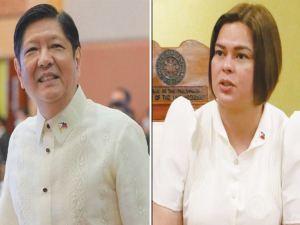Philippine Chief Justice Maria Lourdes Sereno has been ousted by the Supreme Court.
The court issued a ruling on May 11 declaring Sereno disqualified to head the court for “lack of integrity, honesty and probity.”
Eight justices voted to grant the petition for quo warranto initiated by the Executive Branch through Solicitor General Jose Calida.
Six justices voted against the decision.
Malacanang welcomed the high court’s decision.
“The Supreme Court is the final arbiter of the law,” Palace spokesman Harry Roque Jr. said in a statement.
“The High Court has spoken. Let us respect its decision granting the quo warranto petition as the proper remedy and the quo warranto petition ruling against Chief Justice Ma. Lourdes Sereno,” he said.
Roque, a lawyer, added that the Supreme Court is “duty-bound to uphold the Constitution.”
In a separate statement, Chief Presidential Legal Counsel Salvador Panelo said the Supreme Court in issuing such ruling was “only performing its constitutional duty of interpreting the provisions of the Constitution and rendering a decision on cases properly brought before it.”
Panelo explained that quo warranto and impeachment are two different legal modes of removing public officers, noting that the latter removes qualified impeachable officers while the former ousts unqualified public officials.
Sereno was appointed to the post by President Benigno Aquino 3rd, after Chief Justice Renato Corona was ousted by the Senate impeachment court in 2012 for his failure to fully disclose his wealth.
Corona died of cardiac arrest in April 2016.
The decision, penned by Associate Justice Noel Tijam, declared Sereno “guilty of unlawfully holding and exercising the Office of the Chief Justice.”
“The position of the Chief Justice of the Supreme Court is declared vacant and the Judicial and Bar Council is directed to commence the application and nomination process,” it said.
The decision was to be executed immediately, “without need of further action from the Court.”
Moreover, Sereno was ordered to show cause within 10 days why she should not be sanctioned for violating the Code of Professional Responsibility and the Code of Judicial Conduct “for transgressing the sub judice (gag) rule and for casting aspersions and ill motives to the Members of the Supreme Court.”
Sereno, a former law professor at the University of the Philippines, became only the second chief justice to be kicked out of office.
Sereno, 57, was the youngest to be named to the Supreme Court and the first woman to lead the judiciary.
“I am a victim today,” she told reporters in a news conference. “But I am just one thousands upon thousands whose lives have been snuffed out, who continue to remain in detentions, who have been unfairly accused, unfairly victimized by the very powerful forces of society that must be exposed for what they are.”
The ousted chief magistrate claimed a “moral victory,” noting that she would have won, 6-2, if six justices she had accused of bias against her had inhibited.
Sereno was referring to Associate Justices Teresita Leonardo de Castro, Noel Tijam, Francis Jardeleza, Diosdado Peralta, Lucas Bersamin, and Samuel Martires, who voted in favor of the petition to oust her along with Associate Justices Andres Reyes Jr. and Alexander Gesmundo.
The dissenters were Senior Associate Justice Antonio Carpio and Associate Justices Presbitero Velasco Jr., Mariano del Castillo, Estela Perlas-Bernabe, Marvic Leonen and Benjamin Caguioa.
The high court ruled that Sereno’s appointment as chief justice was void from the beginning for her failure to file the required number of statements of assets, liabilities and net worth (SALNs) when she applied for the post.
Sereno had argued that she could only be removed through impeachment under the 1987 Constitution.
Calida lauded the high court for its decision, calling it a “clear exercise of judicial independence even against the highest official of the judiciary.”








